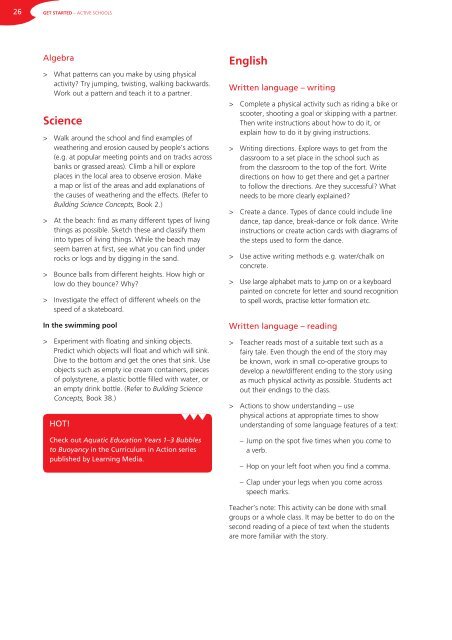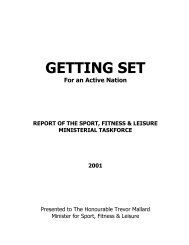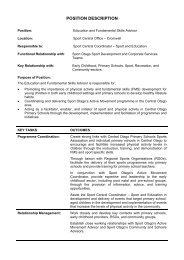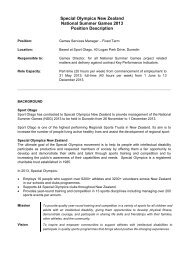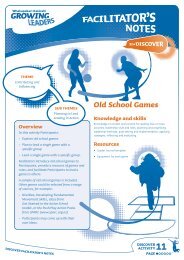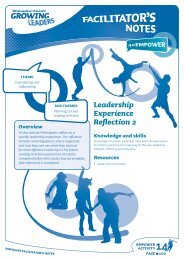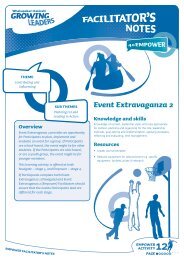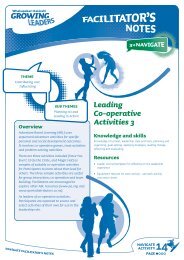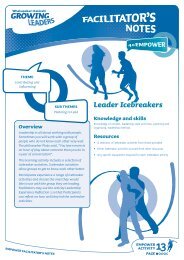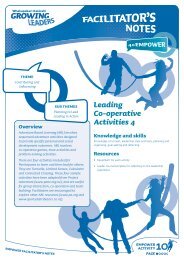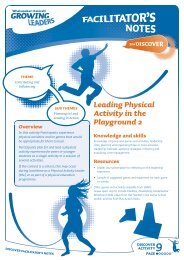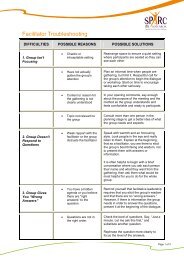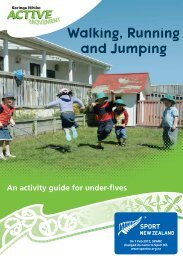Download Get Started (one document) - Sport New Zealand
Download Get Started (one document) - Sport New Zealand
Download Get Started (one document) - Sport New Zealand
Create successful ePaper yourself
Turn your PDF publications into a flip-book with our unique Google optimized e-Paper software.
26<br />
GET STARTED – ACTIVE SCHOOLS<br />
Algebra<br />
> What patterns can you make by using physical<br />
activity? Try jumping, twisting, walking backwards.<br />
Work out a pattern and teach it to a partner.<br />
Science<br />
> Walk around the school and find examples of<br />
weathering and erosion caused by people’s actions<br />
(e.g. at popular meeting points and on tracks across<br />
banks or grassed areas). Climb a hill or explore<br />
places in the local area to observe erosion. Make<br />
a map or list of the areas and add explanations of<br />
the causes of weathering and the effects. (Refer to<br />
Building Science Concepts, Book 2.)<br />
> At the beach: find as many different types of living<br />
things as possible. Sketch these and classify them<br />
into types of living things. While the beach may<br />
seem barren at first, see what you can find under<br />
rocks or logs and by digging in the sand.<br />
> Bounce balls from different heights. How high or<br />
low do they bounce? Why?<br />
> Investigate the effect of different wheels on the<br />
speed of a skateboard.<br />
In the swimming pool<br />
> Experiment with floating and sinking objects.<br />
Predict which objects will float and which will sink.<br />
Dive to the bottom and get the <strong>one</strong>s that sink. Use<br />
objects such as empty ice cream containers, pieces<br />
of polystyrene, a plastic bottle filled with water, or<br />
an empty drink bottle. (Refer to Building Science<br />
Concepts, Book 38.)<br />
HOT!<br />
Check out Aquatic Education Years 1–3 Bubbles<br />
to Buoyancy in the Curriculum in Action series<br />
published by Learning Media.<br />
English<br />
Written language – writing<br />
> Complete a physical activity such as riding a bike or<br />
scooter, shooting a goal or skipping with a partner.<br />
Then write instructions about how to do it, or<br />
explain how to do it by giving instructions.<br />
> Writing directions. Explore ways to get from the<br />
classroom to a set place in the school such as<br />
from the classroom to the top of the fort. Write<br />
directions on how to get there and get a partner<br />
to follow the directions. Are they successful? What<br />
needs to be more clearly explained?<br />
> Create a dance. Types of dance could include line<br />
dance, tap dance, break-dance or folk dance. Write<br />
instructions or create action cards with diagrams of<br />
the steps used to form the dance.<br />
> Use active writing methods e.g. water/chalk on<br />
concrete.<br />
> Use large alphabet mats to jump on or a keyboard<br />
painted on concrete for letter and sound recognition<br />
to spell words, practise letter formation etc.<br />
Written language – reading<br />
> Teacher reads most of a suitable text such as a<br />
fairy tale. Even though the end of the story may<br />
be known, work in small co-operative groups to<br />
develop a new/different ending to the story using<br />
as much physical activity as possible. Students act<br />
out their endings to the class.<br />
> Actions to show understanding – use<br />
physical actions at appropriate times to show<br />
understanding of some language features of a text:<br />
– Jump on the spot five times when you come to<br />
a verb.<br />
– Hop on your left foot when you find a comma.<br />
– Clap under your legs when you come across<br />
speech marks.<br />
Teacher’s note: This activity can be d<strong>one</strong> with small<br />
groups or a whole class. It may be better to do on the<br />
second reading of a piece of text when the students<br />
are more familiar with the story.


